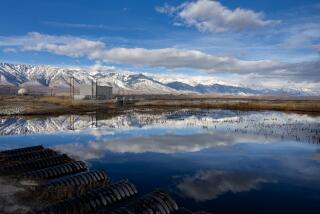L.A. Dry Spell Sets a Record
Hot, muggy, monsoonal weather Wednesday continued to bake Los Angeles, a city parched by the longest dry spell on record.
The National Weather Service said there has been no measurable rain at the Civic Center since Feb. 17, when 0.02 of an inch fell there. That’s 198 days, breaking the 70-year-old record of 197 days, set between April 12 and Oct. 27 in 1927.
Forecasters say there’s a good chance the new record will continue to grow, probably for several more weeks. Despite all the talk of the El Nino phenomenon and what promises to be an unusually wet fall, winter and spring, measurable rain is not expected to begin until late this month or early October.
While 198 days sounds like a long time, it does not constitute a drought, state water officials said. Substantial rains fell throughout California early last winter, and most reservoir levels are comfortably high, especially in light of the heavy rains expected within a few months.
For the past couple of days, high-altitude winds circulating clockwise around a ridge of high pressure over the Rocky Mountains have been pumping moist, tropical air from Mexico into Southern California, and similar conditions are expected today.
That means another hot day and warm night here, along with scattered thunderstorms over the deserts and mountains. There is a slight chance that one or two of these storms might creep over the mountains and into some foothill communities in the Los Angeles Basin, but there probably will not be any measurable rain at the Civic Center, forecasters said.
John Sherwin, a meteorologist with WeatherData Inc., which provides forecasts for The Times, said that the burgeoning El Nino phenomenon probably did not cause the current monsoonal conditions--which occur about this time almost every summer--but that it may have exacerbated them.
El Nino--Spanish for “the child,” so named because it was first observed at Christmas--involves the interplay between warm ocean currents off the west coast of South America and changes in atmospheric temperature, wave patterns and rain levels throughout much of the Western Hemisphere.
Ocean temperatures already are as much as five degrees above normal along the West Coast, much as they were in the months preceding the disastrous El Nino rains and flooding during the winter of 1982-83.
Sherwin said that the warmer water means warmer air, and that warmer air can carry more of the monsoonal moisture that leads to muggy weather here and the sort of severe desert thunderstorms that have hit Arizona, Nevada and Southern California in recent weeks.
The high temperature Wednesday at the Civic Center was 94 degrees, following an overnight low of 76. Both readings were 10 degrees above normal, and the low matched the record high minimum for the date, set during a prolonged heat wave in 1955.
Of considerably more concern than this week’s humid weather are the wind, rain and waves expected within a few months. Forecasters say rainfall this winter could be 300% of normal, and workers are cleaning storm drains and bolstering levees, while emergency evacuation crews are being trained. Relentless El Nino storms in 1982-83 caused damage in California estimated at more than $250 million.
More to Read
Sign up for Essential California
The most important California stories and recommendations in your inbox every morning.
You may occasionally receive promotional content from the Los Angeles Times.










